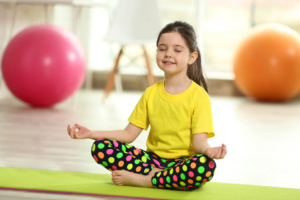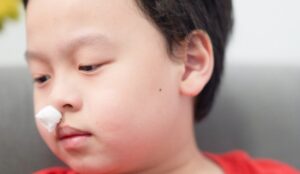Child's pose, also known as Balasana, is one of the most calming and beneficial poses for kids. This gentle, restorative posture encourages relaxation, stretches the body, and helps improve breathing. It's a wonderful way for kids to unwind and develop mindfulness.
How to Do the Child’s Pose for Kids
- Start in a kneeling position: Have your child sit on their knees with their big toes touching and their knees spread apart. Their hands should rest comfortably on their thighs.
- Move into the Child’s Pose: Instruct your child to slowly lower their torso forward, bringing their forehead to the floor. They should stretch their arms out in front of them on the mat, or they can rest their arms alongside their body, whichever feels most comfortable.
- Focus on breathing: Encourage your child to take deep, slow breaths as they settle into the pose. Remind them to relax their body and allow their breath to be calm and steady.
- Hold the pose: Your child can stay in Child’s Pose for several deep breaths or as long as they feel comfortable. It is a restorative pose, so they should not feel rushed.
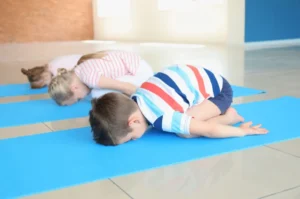
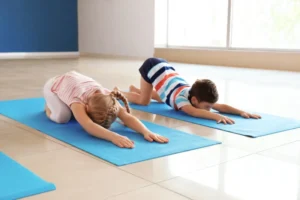
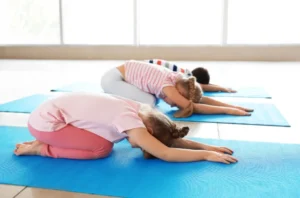

Benefits of the Child’s Pose for Kids
- Promotes relaxation: Child’s Pose is known for its calming effects, helping kids to reduce stress and anxiety.
- Stretches the back and hips: This pose gently stretches the spine, back muscles, and hips, providing a soothing release of tension.
- Improves breathing: By focusing on deep, slow breaths, children can learn better breathing techniques that help them focus and relax.
- Encourages mindfulness: Child’s Pose helps children connect with their body and mind, promoting awareness of their physical sensations and thoughts.
Tips for Teaching the Child’s Pose to Kids
- Keep it relaxing: Emphasize that this pose is all about comfort and relaxation, so they can rest in the position for as long as they like.
- Encourage slow breathing: Remind your child to breathe in through the nose and out through the mouth, making their breath slow and controlled.
- Use props: If your child finds it difficult to keep their forehead on the floor, they can use a cushion or folded blanket under their head for extra comfort.
Child’s Pose V.S. Extended Child’s Pose
Both Child’s Pose (Balasana) and Extended Child’s Pose (Utthita Balasana) are relaxation poses in yoga, but they have key differences in positioning and benefits.
1. Child’s Pose (Balasana)
- Arm Position: Arms are resting alongside the body, palms facing up or down.
- Torso Position: Chest rests on or near the thighs.
- Head Position: Forehead touches the mat.
- Benefits:
- Deep relaxation and grounding.
- Stretches the lower back, hips, and thighs.
- Helps with breath awareness.
2. Extended Child’s Pose (Utthita Balasana)
- Arm Position: Arms are stretched forward with palms pressing into the mat.
- Torso Position: Chest reaches forward, creating a deeper spine stretch.
- Head Position: Forehead rests on the mat, but the chest is more open.
- Benefits:
- Greater spinal extension and deeper shoulder stretch.
- Helps open the upper back and arms.
- Can relieve tension in the shoulders and neck.
Key Differences
| Feature | Child’s Pose | Extended Child’s Pose |
|---|---|---|
| Arm Position | Alongside body | Stretched forward |
| Spine Stretch | Gentle | Deeper extension |
| Shoulder Engagement | Relaxed | Actively stretched |
| Focus | Restorative, grounding | Active, lengthening |
Both poses are great for relaxation and flexibility, but Extended Child’s Pose provides a deeper stretch for the upper body. 😊
Child’s Pose is a wonderful pose for kids to incorporate into their yoga practice. It’s easy to do, helps with flexibility, and brings a sense of calm and peace. Perfect for winding down after a busy day or before bedtime.






